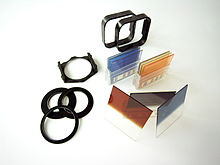Filters (photography)
Filters are elements of an optical system in the photograph mostly in front of the lens of the camera can be attached to the image before it impinges on lens and film or image sensor to change. This is done by the nature and materials of the filter.
application
Filters are used in photography as correction filters and as effects filters . Can be changed saturation , contrast , UV light , or it can also, and effects like stars are added.
Most filters reflect some of the incident light so that less light reaches the lens. This exposure reduction is indicated by the filter factor. This is usually indicated on the holder of the filter.
Important filters are:
- Polarization filter (also called polarization filter for short)
- UV blocking filters (usually referred to as UV filters) and skylight filters
- Color filters or conversion filters and correction filters (red, green, blue, yellow etc.)
- special optical filters
- Infrared cut filter
- Neutral density filter (short ND filter, usually also called gray filter)
- Effect filters (e.g. star, rainbow and gradient filters )
- Close-up lenses (not filters in the strict sense, but are often attached and sold like these)
In digital photography , many filters are hardly used any more, as the effects can in many cases be applied to photographs afterwards with the help of image processing and an image processing program (especially effect and color filters; see graphic filters ). However, ND and polarizing filters are still irreplaceable. Furthermore, digital cameras almost always have a built-in infrared cut filter between the lens and the image sensor .
Correction filter
Common correction filters in black and white photography are yellow , orange and red filters . They dampen the blue component and thus make pictures with blue or white components ( sky ) in particular more contrasting.
A whole range of colored filters are available for color photography . Red -brown filters and the various blue filters for using an artificial light film in daylight or a daylight film in artificial light should be emphasized .
A frequently used filter in both color and black and white photography is the skylight filter . It prevents a blue cast.
Remove polarization filters (or intensify, depending on the setting of the polarization filter) the reflections on non-metallic surfaces. In addition, the colors appear more intense.
Effects filter
There are innumerable effects filters; The most commonly used include soft focus and filters that can be used to create halos around light sources. There are also various color filters, gradient filters and other trick filters.
Filter adapter

Filter adapters are required in order to be able to connect filters to a lens of a camera. A distinction can be made between screw-in and plug-in filters for the filters. Accordingly, there are also different adapters for these purposes.
Screw filter
Due to the variety of filter threads, there are filter adapters to connect filters to lenses with different filter thread diameters. So that the filter does not generate additional vignetting , it only makes sense to connect larger filters to smaller threads.
The designation 52 → 55 indicates that a 55 mm filter can be adapted to a lens with a 52 mm thread.
The use of several screw filters on ultra-wide angle lenses is problematic. The resulting build-up in front of the lens can cause vignetting. Therefore, when using several filters (e.g. combination of ND, gradient and polarizing filters), a filter holder with plug-in filters makes sense.
Plug-in filter
With plug-in filters, various accessories such as filters, lens hoods or lens caps can be attached to different sized filter threads . A filter can thus be used on a wide variety of lenses. All you need is a filter holder and a suitable adapter ring with the filter diameter of the respective lens. So you don't have to buy the right accessory for every lens.
In addition, plug-in filter systems have the advantage that vignetting does not occur so quickly on wide-angle lenses. Especially in the ultra-wide angle range, several filters can be combined with sufficiently large plug-in filter systems. Combinations that lead to vignetting with screw-in filters are still possible.
High-quality plug-in filters that from the CR-39 - Polymer are made, have an optical quality comparable to that of crown glass is and is not inferior to the classic screw-in glass.
However, these filters scratch more easily than the versions made of glass, which is why some manufacturers continue to rely on glass for their high-quality filter series.
Graphic filter
In digital image processing , the effect of many optical filters can be created using so-called graphic filters .
literature
- Arthur Freiherr von Hübl: The photographic light filter . Knapp, Halle 1910.


